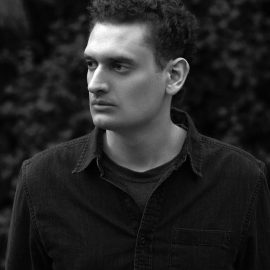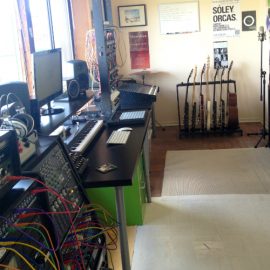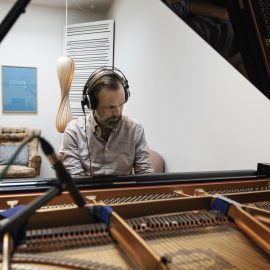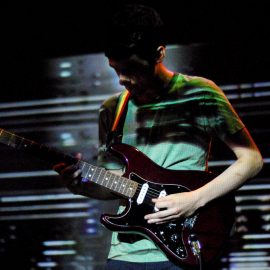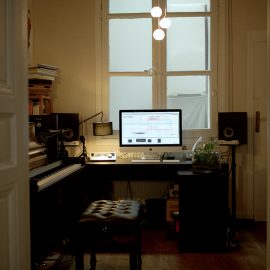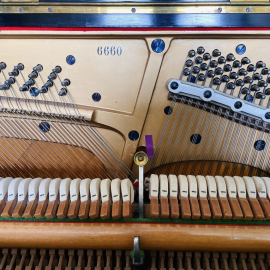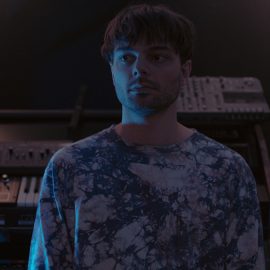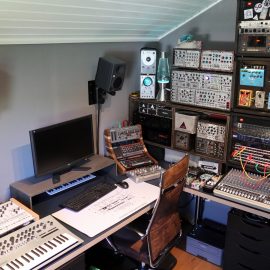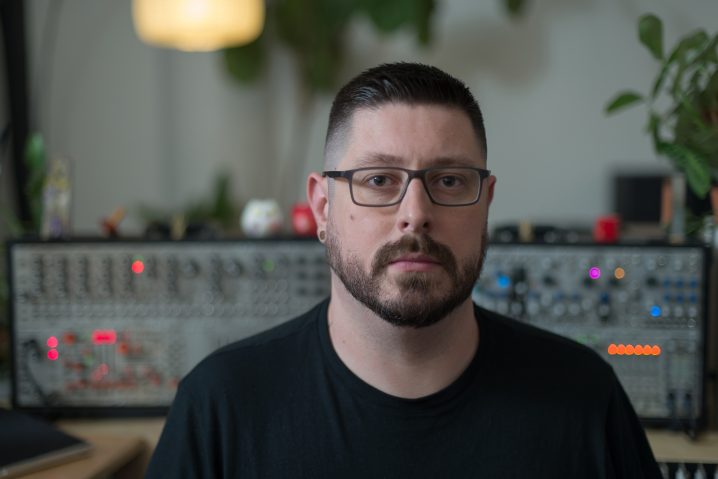
Let’s start at the very beginning. Can you tell us how you got involved in composing, and what was your very first piece of gear?
In the 90’s I was heavily involved in the midwest rave scene and did some DJing. Towards the end of the 90’s I started to get into the ambient and experimental side of electronic music, started to get more into DJing, and also started to branch out gear wise. So I guess my first piece of gear other than a pair of turntables was a BOSS SP-202 Dr. Sample. Shortly after, I had to sell everything to fund a move to Seattle and it took me until 2002 to afford a laptop, an iBook if I remember correctly. That was the first piece of gear that contributed to my current studio practice. Shortly after that I was invited to participate in a program called Super 8 that was part of the Seattle Lesbian and Gay Film Festival in which non-filmmakers are given a roll of Super 8 film and a camera to make a film. I decided to score it as well, and that was the first public presentation of my work. Soon after, a coworker and choreographer was looking for someone to score her next full-length dance piece – she invited me and I went from having scored a three-minute experimental film to spending over a year composing a score for an hour-long dance piece. I guess you could say I got involved by hitting the ground running.
How many different studio iterations have you gone through, and what does your final setup look like right now?
I have had at least eight different spaces over the years, always part of my living space, but I can’t tell you how many variations because I like to rearrange things quite often. My studio mainly changes due to my visual practice, either needing printer space, painting space, or projection space. My current iteration has probably had the most longevity, it has stayed the same for just over 2 years now. My audio setup has stayed pretty much the same throughout the years. It’s based around a laptop running Ableton Live, a mixer (currently a Mackie 802), an audio interface (currently an Apogee Quartet), some kind of MIDI controller (currently an Ableton Push 2) and of course a field recorder (currently a Zoom H6). In the last few years I have expanded a bit: slowly built a modular synthesizer over time, added a few pedals and this weird and wonderful little synth called the Drone Commander. I also have an iMac for my heftier video rendering needs. It is also tasked with all my administrative chores which is a gift when I am working with sound and don’t have to have emails and notifications buzzing in my face and ears.
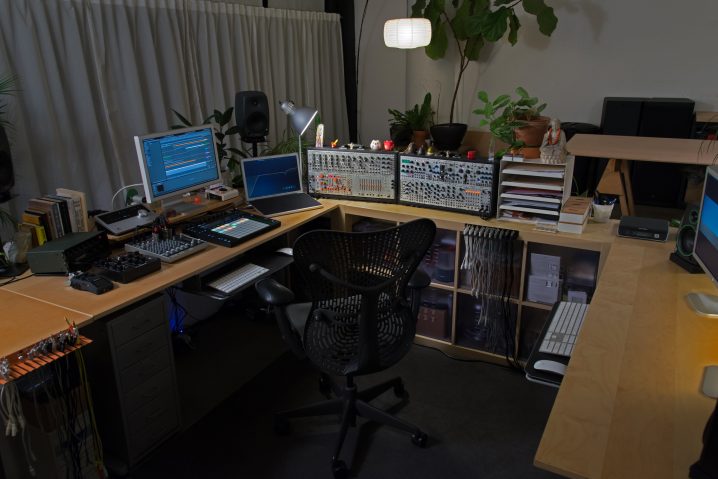
Tell us about your favorite piece of hardware.
For a long time it was my Sony PCM-D50 field recorder, but after 10 years it had to retire and I have not had a chance to try its replacement. Because I have shifted away from field recordings towards modular synth I would have to say my current favorite is the Eventide H9 Harmonizer/Effects Processor. When I started integrating synths into my workflow it was really hard to wrap my head around their mono signals. Coming from using stereo field recordings exclusively, everything I was making with the synth felt dead and lifeless, one-dimensional. The Eventide H9 gives me the ability to place the synth in a stereo field and give it depth and space so it can sit more comfortably within a field recording. It also offers some really dense algorithms that can transform a synth or field recording almost completely. I have had it for just over a year now and I feel like I have only scratched the surface which is really exciting!
And what about the software that you use for production?
I have always used Ableton Live as my DAW, I have used Reaktor on and off for years, and different free things here and there as they appear and then become unsupported or outdated. I think software-wise, EQs are the most important tool in my studio. I use one or two on every track and on the master of pretty much everything I do. I used to use one called Periscope by Audio Ease that had 32 bands, but you could zoom in on a small part of the frequency range and that range would still have 32 even finer bands. It was amazing for getting really precise, but sadly it has been discontinued and became intolerably buggy for me about a year ago. At that point a switched to this beautiful EQ by Fab Filters called the Pro-Q 2. It has all the precision of Periscope without its severity. It’s amazing the kind of transformation that’s possible with just an EQ.
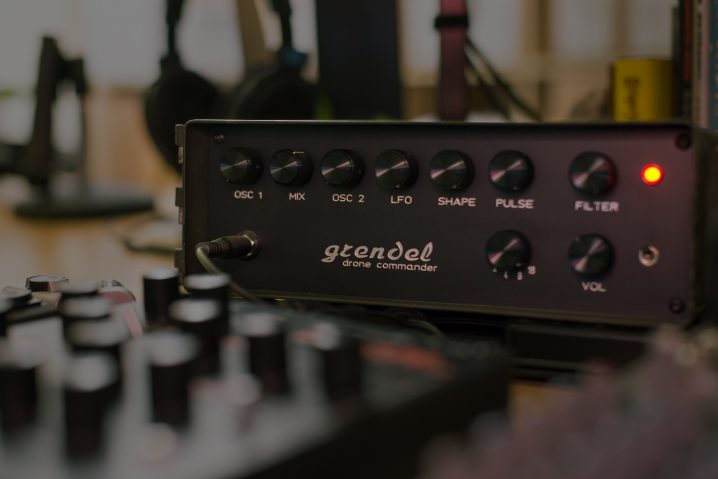
Is there a particular piece of gear that you’re just dying to get your hands on and do you think one day you’ll have it?
I am quite happy with my studio right now and even paring down the modular, but I have always lusted after a rack-mounted Eventide Effects Processor. I would love to give the Eclipse or the H7600 a go. I share a studio with my partner Robert Crouch, who has an Eclipse, so I know how amazing it can sound, but we both have really specific signal paths on our individual sides of the studio and I would be terrified to start messing with it only to find that he had it set up for a really particular thing he was working on. So for now, we keep things separate. I am happy with my H9 and if I can ever pay down some of my modular debt maybe I will go into Eventide debt instead. I have always dreamed of having a rack-mounted something or other.
Can you please share some aspects of sound design in your work?
My process usually revolves around a single field recording. Each composition would use just one recording and I would render as many processed iterations and variations of it I could. Then when I had exhausted the recordings I would start combining those elements and build the composition. This is still very much a part of my process but now I do something similar with the modular synth, where I create a patch and record multiple variations until I have exhausted that patch, then tear it down and repeat. Once the dust has settled I go back and eliminate everything I don’t like and further process the things I do like, sometimes again making multiple variations. I also un-patch the modular between every project so it feels similar to starting with a fresh field recording. This process results in each project having a 15 – 25GB folder of files. Very costly to archive!

Any particular new techniques that you tried out for your new album?
On my new release for Touch, Ornamentation, I actually did something pretty different where I went back through my archive of field recordings and used only my rejects. So I was using flawed recordings from different projects over the last 10 years, mixing multiple sources, locations, and recording devices. It became a total mess, but that was my intent. With this release, I really wanted to make it as hard on myself as possible, as laborious as possible. When working with one field recording over and over I don’t really have to worry about pacing or space because no matter what I do to the recording it always inherits a kind of DNA that will work with other variations. On Ornamentation I had to spend a lot more time pairing sound because one might loop really quickly and if a second sound had to close a loop they would create a rhythm, or maybe one was originally mono recorded on my phone and I had to simulate space for it – how would that sit with something naturally spacious? It became a jigsaw puzzle and I think the ending composition was the only way they would all fit together harmoniously. Now that it’s over I am really happy with the work I put in because I think it really spoke to the ideas I was grappling with in the piece.
What does your live setup look like, and what do you bring with you when you travel for an extensive tour?
I never go on extensive tours, maybe 3 dates max, but my live setup is always the same. I have my laptop, an Apogee Duet audio interface and a MIDI controller (right now it’s an AKAI APC Mini), and a copy of my set on my keychain thumb drive. When I first started performing I never had a laptop beefy enough to do a lot of live processing, so I got in the habit of mixing rendered files which fits my compositional style just fine. I also can’t afford to upgrade my laptop very often so it’s often a little iffy (my current laptop has a mysterious vertical red line through the screen that comes and goes). All this uncertainty has led me to create a live set-up that could be easily duplicated if anything goes wrong. For instance, I now only use the built-in effects in Ableton Live if I need effects for a live set. I also chose the AKAI controller because it’s $100, so if it ever gets broken or lost on the road I can hit a Guitar Center or something wherever I am and get a new one. That is also why I have my live set on my thumb drive, so in a worst-case-scenario, I could potentially play it off any laptop with Ableton Live installed. It’s not a sexy answer, but it sure reduces a lot of travel stress when you are poor and traveling to perform.
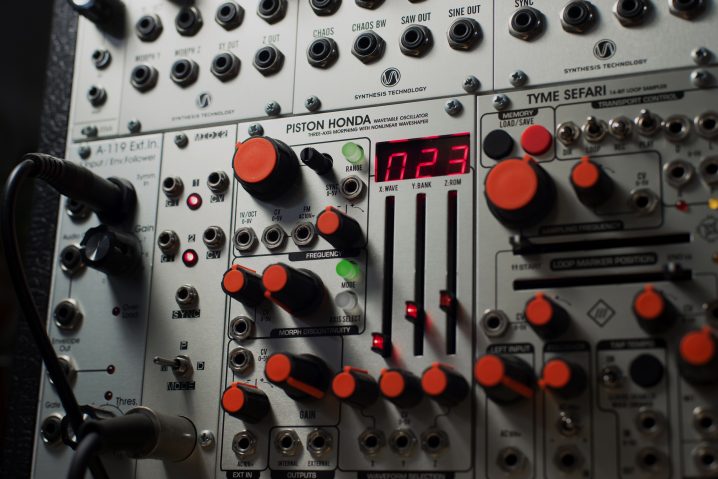
What is the most important environmental aspect of your current workspace and what would be a particular element that you would improve on?
Our new loft is huge – which I love because I don’t work very loudly, so I don’t have to worry about reflection or room treatment that much. The cool thing about the complex we are in is that it’s an old brewery and our particular building used to be the distillery, so there is a layer of cork on the large metal beams on the ceiling and on the concrete columns. I think it was used for keeping the humidity even? But whatever reflection there would be in a big concrete box like this is absorbed by the cork. I think the only improvement I could make is to figure out how to afford more time to work on sound.
What can you tell us about your overall process of composition? How are the ideas born, where do they mature, and when do they finally see the light?
It varies from piece to piece, sometimes it’s a field recording, sometimes it starts with the visual component, other times it comes from an invite to exhibit or perform in a specific venue or location. Once the idea is there I usually circle it for a while and think about it before I try to work on it in the studio. I also have multiple jobs so I don’t have a huge amount of time in the studio, but that works out well because I like to let myself get a little pent up and excited about the idea before I let myself work on it, then I lock myself away until the idea is totally fleshed out and either finished or it’s in the garbage. There is a real ebb and flow of activity and what might seem like idleness, but it’s really a need to really sit with ideas and nurture them before trying to bring them to fruition.
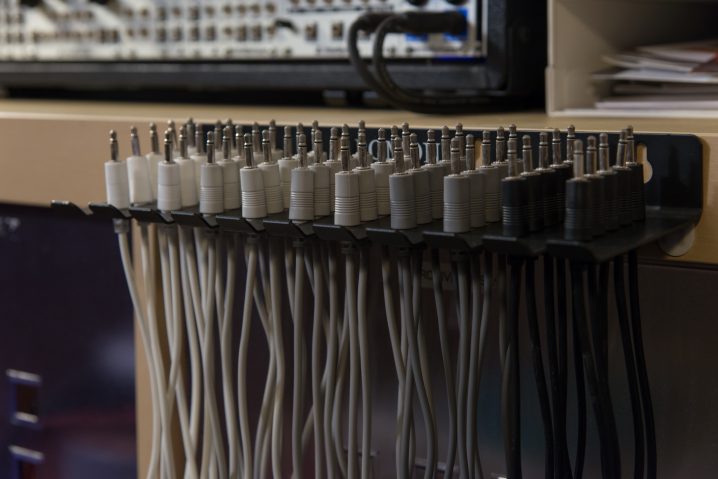
After the piece is complete, how do you audition the results? What are your reactions to hearing your music in a different context, setting, or a sound system?
I consider a piece finished when I can listen to on a loop in my studio and not need to pick it apart. Then I enter the part I hate, where it gets played on lesser-quality speakers so I can make sure the mix is similar on other speakers. That stage is then done if I can make it through once on those speakers without picking it apart. Finally I need to walk away from it for about 2 months so I can forget how I made it and why I made all the decisions I did. After 2 months I can listen to it objectively, but during that two months there is a transitional stage where I kind of remember how I did things, but maybe forget why I left something in or why I made some that transition that way and I just spiral into a pit of insecurity. Thus the two-month rule – so I can avoid the spiral at all costs.
Do you ever procrastinate? If so, what do you usually find yourself doing during those times?
I do, but usually not in any exciting way. Mainly I will work on my label (Dragon’s Eye Recordings), or work for a design client, or answer emails for the artist organization I work for. If it gets really bad I will start making esoteric changes to my website that no user would ever notice or care about. Procrastination for me is about avoiding making work because making work is when I am most exposed and vulnerable, so I look for tasks that keep my mind from that place. I also become a badass house cleaner when I am out of emails to answer.
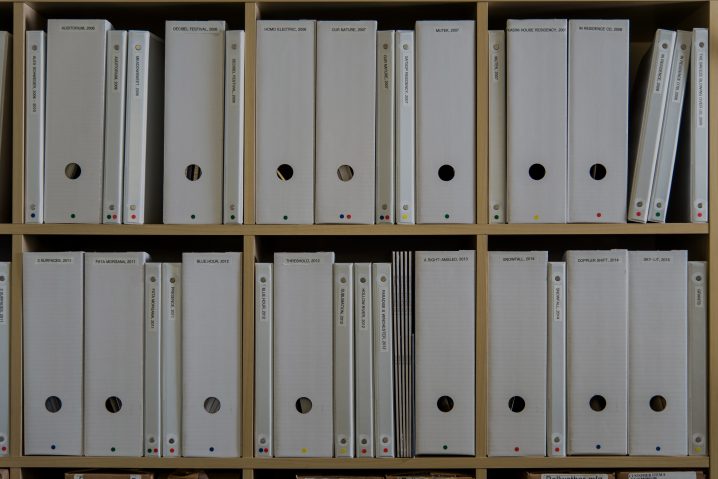
What gets you inspired?
I read somewhere that a studio practice is like breathing, where your own creations are akin to the act of breathing out, and at some point you have to breathe back in. I think it’s a great way to think about being an artist and self-care. So for me, I get inspired from seeing others perform, seeing exhibitions, from altered states of consciousness, or even a simple night out with friends having a drink or a smoke and catching up on what they are doing. I think at its core, my work is about creating spaces for shared experiences and the best way for me to get inspired to do so is sharing experiences with others.
Photography by Christopher Wormald
